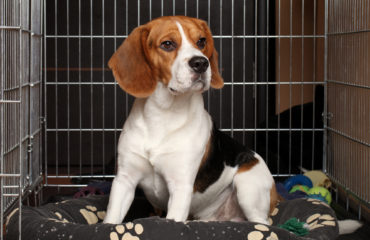What To Expect When Rescuing A Dog

Rescuing a dog can be a time of upheaval, excitement and discovery for both newbie and experienced pet owners because each dog is different, with its own personality and quirks to get used to. Your new companion equally has to adjust to you, your family, home and way of life, which can be a slow process or go rather quickly, depending on the temperament of the dog. For those with no previous background with rescues, here is Benchmark Kennel’s guide on what to expect when you’re expecting (a new fur baby).
Finding A Dog
There are many ways to adopt a dog so it’s best to cast a wide net so you can find the dog who truly fits your family and vice versa. Local rehoming centres may be featured in more traditional modes of advertising like leaflets, local papers, classifieds and directories, as well as having a website to browse.
Larger adoption services almost always have dedicated websites featuring pet databases where you can easily search for specific types of pets in your region and area. You’ll be able to view details like their temperament, their likes and dislikes, ideal environment and individual care needs on their pet profiles.
If you live close enough a rehoming centre, it’s just as easy to drop in branch and visit the dogs currently waiting to be rehomed. It’s important to be aware that some dogs may be reserved for other visitors and prospective adopters, so guard your heart before you fall in love with any specific pooch.
Filling In The Paperwork
Once you’ve found the dog you’d like to rehome you will usually be required to give the centre a ring (or let them know during your visit) and express your interest to meet the dog. You’ll need to fill in an application form downloaded online or pick one up in-person. If you haven’t popped into the rehoming centre previously or live too far away to do so, simply bring the filled documents with you on the day of your visit. The staff at the chosen centre will assess your application with you and give you more information regarding the individual needs of the dog in question and whether you, your family, and they are a good forever home fit.
If your application is approved, you will be allowed to meet your potential pooch and get to know their demeanour a little better. Its recommended that each member of the family is present to make the dog’s acquaintance before choosing to move forward with the adoption process.
A Forever Home
When it’s deemed that your household is a great match for your new companion, most reputable adoption centres will commit to a home visit in which a colleague will drop by your home to ascertain that your space is suitable for the dog you want to adopt. You can pick up some great advice at this stage, so don’t rush through the meeting. It’s advisable to take notes, be open to ideas and be super aware of how the transition from kennels to a normal home can be made smoother and less stressful for the dog with little tweaks, such as bringing a favourite toy with them, or a loved blanket which has their scent all over it.
These simple measures will make them feel more secure in strange surroundings because just like us humans, unfamiliar situations can be extremely distressing without comfort and reassurance from those who love us.
Establishing a supportive forever home is key to the first few weeks of adoption, but don’t be afraid of information overload as most adoption centres will provide you with a handbook break down of help and advice which you can use post-rehoming.
Adjustment Period
After successfully crossing all the T’s and dotting I’s during your application (including a possible single time adoption fee), your new dog will be officially given over to your care. When you take them home most dog’s will have received all their jabs, anti-parasite treatments, microchipping, spaying or neutering. If you’re not sure whether they have been given a medical once over, you may want to take them on a quick trip to see the vet in order to ensure they’re getting the healthiest start at the beginning of their next chapter with you.
Before rushing out into the world though, we advise you to slowly introduce your dog to your home by allowing them free reign of one or two rooms, depending on how timid they are. This smaller territory makes them feel more in control of their environment, think of it as their own little safety den! For an extra level of security for your dog, investing in a dog kennel, crate or cage whose door you can leave open is a fantastic option, as this is where their favourite blanket can be draped or toy placed inside so their scent is present from the word go.
Trust is the most vital factor when your dog is exploring new rooms, a dog who trusts their owner often makes greater progress through the bumpy adjustment period than dogs who are being rushed, stressed or feel their pack leader does not have their best interests at heart.
Like any of us when we’re frazzled, they might just need quality time to feel relaxed in the presence of your household. You can tempt them to be more adventurous by introducing a treat and rewards system, each milestone and achievement should earn them a toy, an enrichment activity or a small dog treat.
Training
The training process for a new dog should ideally take place as soon as they enter your property, set the tone for what kinds of behaviour are welcome and those that are not permitted. The following are some key areas of dog training for you to keep in mind:
- Relationship Building: Do not think of training as a chore or an activity which must be strict and utterly devoid of fun, the goal is to build a meaningful companionship between you (the leader of your pack) and your dog (a member of your pack).
- Toilet Training: This may take longer than you expect until a regular toilet routine is put in place, you may also notice that your dog wants to go to the toilet much more often, this is normal.
- Monitor Walks: Not every dog wants to walk for miles and miles, for some, a short local walk might do the trick. It’s your responsibility to respond to their needs and learn their preferred distances, frequency of walks and usual walk intensity. You’ll learn their patterns over time.
- Lead Discipline: Your dog being able to respond to your call (and their name) when given the freedom to roam off the lead is essential as it can avoid dangerous hazards for them and for others. Train your dog to walk on a lead at home in your garden or yard using rewards, until they learn to respond to your voice promptly, calmly and without fuss. Do not let them off the lead until they are fully able to recognise commands.
Need a bespoke kennel for your new rescue dog?
Benchmark Kennels are a manufacturer of bespoke dog kennels, giving dog owners of all breed types, sizes and temperaments a secure and spacious place to stay outdoors. Every kennel is custom-made, meaning you can choose the exact size, material, properties and architecture of the kennel itself to ensure it suits your dog and the outside of your property.
You can order a wooden or WPC eco-thermal dog kennel directly from our website today or contact us via phone to find out more about our excellent range of kennels.





You must be logged in to post a comment.